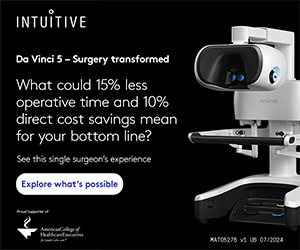
- Transforming Technology Through Teamwork
- Members in the News
- Studies Show Suitability of Robotic Assistance in Emergency Surgery
- Strategic Planning Offers Competitive Edge
Transforming Technology Through Teamwork
Communication between healthcare providers and IT professionals is crucial to the development of useful, efficient clinical technology, according to experts at the Mayo Clinic, UChicago Medicine and Piedmont.
Clinicians frequently default to medical-speak, and “IT folks speak their technical language. They often don’t cross, they don’t connect. But it’s important [that they do] because the technology we select for providers impacts them every day,” says Kay Thiemann, FACHE, emeritus executive administrator for Mayo Clinic and executive director of the Brooks College of Health Leadership Institute at the University of North Florida.
Thiemann and executives from UChicago Medicine Sciences and Piedmont are featured in “How Collaboration Ensures Provider Tech Adoption” from the September/October issue of Healthcare Executive. They discuss their experiences developing new technology, from a replacement for a quarter-century-old 3D viewing system to AI-generated appointment notes.
“You have to be thoughtful, consider most of what you need to do and have the right people at the table,” says Sachin Shah, MD, chief medical information officer and an associate professor of medicine and pediatrics at UChicago. “We’re going to iterate on it. ... You have to succeed or fail fast—and learn from it.”
Members in the News
John “Jack” Lynch III, FACHE, will be retiring as president/CEO, effective June 30, 2025, after 20 years of steadfast dedication and commitment to Main Line Health, Bryn Mawr, Pa. Read more about your peers making headlines in ACHE’s Members in the News.
Studies Show Suitability of Robotic Assistance in Emergency Surgery
While robotic-assisted surgery for elective procedures is well-established, some providers still question its value for emergent and urgent surgery. The recent growth in robotic-assisted emergency general surgery has sparked two new insightful studies.
A retrospective study in JAMA Surgery looked at more than 1 million emergency robotic, laparoscopic and open surgery procedures. Data showed an increase in robotic surgery for several common emergency procedures from 2013 to 2021. The study indicated that patients undergoing robotic colectomy, inguinal hernia repair and ventral hernia repair had shorter postoperative lengths of stay compared to patients having laparoscopic surgery, with a significantly lower risk of conversion to open surgery.
In another study published by the World Journal of Emergency Surgery, researchers analyzed nearly 234,000 emergency or urgent gallbladder surgery cases (open, laparoscopic or robotic) and concluded that robotic-assisted surgery is a safe alternative to laparoscopic surgery and may offer an advantage for class III obesity patients. The findings revealed similar outcomes for intraoperative, immediate and 30-day postoperative complications for robotic and laparoscopic surgeries, with shorter laparoscopic OR time and lower conversion rates for robotic surgery. Both modalities out-performed open surgery.
These studies fill a critical gap in research for the expanding use of robotic-assisted emergency general surgery. While outcomes and complications were similar to laparoscopy in both studies, robotic surgery had a lower conversion rate and similar or reduced length of stay—findings that may encourage continued growth in the robotic approach.
Serious complications may occur in any surgery, including da Vinci surgery, up to and including death. Serious risks include, but are not limited to, injury to tissues and organs and conversion to other surgical techniques, which could result in a longer operative time and/or increased complications. For summary of the risks associated with surgery refer to Safety Information. For product intended use and/or indications for use, risks, cautions and warnings and full prescribing information, refer to the associated user manual(s). Individual outcomes may depend on a number of factors—including but not limited to—patient characteristics, disease characteristics and/or surgeon experience.
Intuitive, a proud supporter of ACHE, provided the content above.
Strategic Planning Offers Competitive Edge
Strategic planning across industries is essential, but healthcare presents unique challenges. In addition to standard concerns of finance and technology, healthcare leaders must also navigate clinical needs, the physician enterprise, value-based care and governance complexity.
With healthcare changing at an unprecedented pace and an intensely competitive environment, healthcare organizations with a sound strategic plan can quickly decide which initiatives to postpone, add or prioritize to adapt to changing conditions.
John M. Harris and Meredith C. Inniger, FACHE, provide a step-by-step guide for every stage of strategic planning and implementation in their newly-revised book Healthcare Strategic Planning, Fifth Edition. The authors have added seven new chapters focused on key issues affecting healthcare organizations. They describe crucial decisions that must be made along the way and the preparatory steps that must be taken for effective planning.
This revised edition contains the most recent research on strategic planning as well as updated best practices. It includes new information on the importance of strategic thinking in management, effective stakeholder engagement, seamless transitions to implementation and securing strategic plan commitment.
Healthcare Strategic Planning equips healthcare executives with the skills necessary to prepare their organizations to successfully navigate the inevitable changes and challenges they face.


